EAT MORE FIBRE DAILY – IT WILL CHANGE YOUR LIFE!
Digestive complaints and discomfort are so common nowadays indicating that we are not eating enough gut-friendly foods, are stressed out and sleep-deprived, and generally ‘too busy’ to look after ourselves properly.
Majority of my clients know that dietary fibre is important for their health but often don’t know the specific benefits or are afraid of fibre as it can cause too much abdominal discomfort and gas when used in excess or a wrong type for you.
By simply eating enough fibre daily so many health problems can be solved or avoided all together changing your health and life for the better! So let’s talk about how to utilise fibre for better health and wellbeing.
Did you know that dietary fibre is only found in plant foods?
Animal foods such as meat, fish, cheese or eggs contain no fibre. It is a carbohydrate that, largely, can’t be digested in the gut and so it does not contribute to the calorie intake of the diet, meaning it will not contribute to any weight gain. In fact, it’s a great tool for sustainable weight loss.
You may have heard that fibre is essential for digestive health but most people still don’t get enough of it daily. How much fibre should you eat each day? Generally between 25-40g per day should be sufficient for most people but it depends on your current gut tolerance and health.
Top 6 reasons to eat more fibre daily
- Digestive aid and soother – reduces/ eliminates digestive problems such as reflux, constipation, bloating, diverticulitis, Irritable Bowel Syndrome (IBS) and haemorrhoids.
- Detox aid and facilitator – due to our constant toxin exposure nowadays, you need to increase fibre intake to better eliminate these toxins via the bowels. Fibre binds many toxins in the digestive tract and escorts them safely out of the body.
- Blood sugar balancer – it decreases your chances of developing diabetes and metabolic disorders by balancing blood sugar levels.
- Reduces sugar cravings – it helps to reduce sugar cravings because it takes longer to absorb in the blood stream so it will keep you full for longer. By including good amount of fibre at breakfast and lunch you’ll find those 3pm energy dips decrease or disappear all together.
- Improves metabolism and helps with weight loss – it supresses appetite, you feel more full and satisfied with your meals thus decreasing snacking and cravings.
- Prevents / reduces the risk of heart disease by lowering blood cholesterol – it binds excess cholesterol and helps to excrete it.
There are three main types of fibre
- Soluble fibre – often described as mucilaginous or slippery, since it has the capacity to carry lots of water thereby forming a gel in the intestines. It binds fats and stays longer in the gut allowing sugar from digested foods to be released and absorbed more slowly. This can help lower LDL cholesterol, while maintaining HDL cholesterol thus reducing your risk of heart disease, and helps constipation or the symptoms of irritable bowel. Soluble fibre is found in fruit and vegetables, some grains (e.g. oats, barley), psyllium, flaxseed, slippery elm and in legumes (dried peas, beans and lentils).
- Insoluble fibre – often described as ‘roughage’ that acts like a sponge for the large intestine. It is more resistant to digestion, and is fermented by bacteria to produce special fatty acids needed for the health of the gut wall. Insoluble fibre is found mainly in wholegrain foods (especially wheat bran and rice bran), the skins of fruits and vegetables, nuts and dried beans, and grains such as brown rice, millet or quinoa. It helps to prevent constipation by producing bulky stools, speeding bowel transit time and helps to move toxins through the large intestine more quickly. It also helps with regulating appetite, blood sugar balancing, and aiding in weight control because it makes you feel full for hours after consumption.
- Resistant fibre/ starch – it’s the newest type which is becoming really useful not only in diabetes and metabolic syndrome but also in adrenal fatigue which is associated with blood sugar dysregulation and gut disorders. The key benefit is that resistant starch creates little to no insulin response, unlike any other carbohydrate. It is digested only by the beneficial bacteria many hours after consumption, making it also a valuable prebiotic (i.e. food for good bacteria). Resistant starch is found in whole grains, cooked/ baked and cooled potatoes, lentils and firm bananas (see more information below).
All three fibres are important for health and eating a combination of them daily is essential. This can be achieved quite easily by including a variety of fruits, vegetables, grains, beans and legumes in the diet. Is your gut sensitive after eating fibre i.e. you experience bloating, gas and/ or abdominal discomfort? Test for food intolerances to find out which foods are inflammatory for your body, and which ones are safe to eat.
Best sources of fibre
- VEGETABLES – they are the top source of fibre when eaten with skins and edible seeds. Highest sources include:
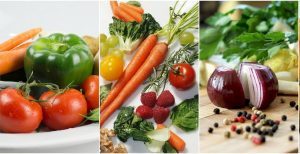
- Artichokes (6.5g per globe)
- Broccoli (5g per cup)
- Sweet potato (baked, 5g per cup)
- Spinach (cooked, 5g per cup)
- Oats (cooked, 4-5g per cup)
- Pumpkin (cooked, 3g per cup)
- Cauliflower (cooked, 3.5g per cup)
- Asparagus (cooked, 2g per 4 spears)
- Mixed steamed vegetables (5-8g per cup)
- FRUIT – when eaten with skins and edible seeds (these are excellent sources of fibre). Highest sources include:
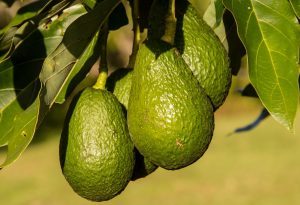
- Avocados (7-9g per fruit)
- Berries (3-8g per cup)
- Raspberries (7-8g per cup)
- Prunes (4.5g per 6 medium prunes)
- Pears (5-6g per fruit)
- Apples (4-5g per fruit)
- Passion fruits (5g per fruit)
- Mangos (3-5g per fruit)
- Kiwi fruits (2-3g per fruit)
- NUTS AND SEEDS – a handful of nuts everyday makes it a great snack as they also include both good fats and proteins. Highest sources include:
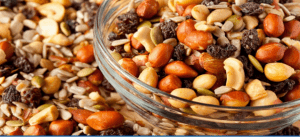
- Almonds (3.5g per 20 almonds)
- Hazelnuts (1.5g per 10 nuts)
- Walnuts (2g per 5 nuts)
- Pecans (2.7g per 20 halves)
- Brazil nuts (2.1 per 6-8 nuts)
- Flaxseeds (3g per 1 tbsp)
- Sunflower seeds (5g per 1/3 cup)
- Pumpkin seeds (1.8g per 1/3 cup)
- Chia seeds (6g per 1 tbsp)
- BEANS, PEAS AND LEGUMES – very good sources of mainly soluble fibre as well as resistant starch. Green beans are one of the best sources of fibre
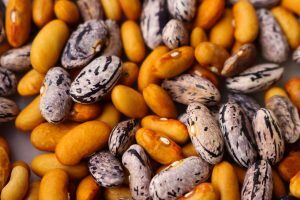 and are easier to prepare and digest. Highest sources (fibre per cup) include:
and are easier to prepare and digest. Highest sources (fibre per cup) include:- Cannellini beans (canned, 16g)
- Split peas (cooked, 16g)
- Lima beans (cooked, 13g)
- Lentils (cooked, 15g)
- Chickpeas (cooked, 8g)
- Green beans (cooked, 8-9g)
- Baked beans (7g)
Daily fibre intake recommendations
Daily fibre intake recommendations vary between 25-40g per day, depending on your gut tolerance levels and current health status. It’s really easy to achieve it!
Here is an example of a daily menu using the above foods to create your meals:
- Breakfast: 1 cup of cooked oats (5g) + 1 tsp of chia seeds (3g) + ½ cup of blueberries (3g) = 11g
- Lunch: 1 cup of baked sweet potato (5g) + 1/2 avocado (4g) + grilled fish (0g) = 9g
- For dinner: 1 cup of mixed vegetables (8g) + 1/2 cup of cooked lentils (dhal) (8g) + meat (0g) = 16g
- Total fibre: 36g of fibre per day. How easy is this?!
Important – larger that recommended amounts of fibre (more than 40g per day) are not desirable/ recommended. Excess fibre can bind essential minerals like zinc, calcium and iron forming insoluble salts, which are not utilised by the body but excreted. Excessive intake can also cause too much gas, abdominal pain and diarrhoea or constipation.
Also, make sure you eat the high fibre foods a bit at a time throughout the day and not in one seating. Eating lots of fibre all at once or taking fibre supplements can result in the above mentioned abdominal symptoms or constipation.
How to increase your daily fibre intake
The following strategies, many were effectively implemented by my clients, will help you to increase your fibre intake on a daily basis:
- Eat a high-fibre breakfast such as baked beans on wholegrain toast or with rice or quinoa plus steamed vegetables or green salad.
- Eat wholegrain breads (if tolerated, not suitable when on a gluten-free diet).
- Add beans, lentils and peas to soups, casseroles, salads and as a side dish such as dhal (lentil dish) or hummus with vegetables.
- Eat pea or lentil based dishes a few nights a week. Good examples are falafels, chickpea salad, hummus, dhal or lentil soup plus well-cooked rice (brown or white), and mixed steamed vegetables.
- Eat fruit and vegetable with skins, don’t peel them. Chewing well is essential to help digestion, minimise gas or cramps.
- Snack on fruit with added nut butters (e.g. almond butter) or raw nuts and seeds.
- Eat whole fruit instead of drinking fruit juice as it has minimal fibre. Smoothies are better as they retain the fibre.
- Soak beans and legumes overnight, if using dried ones. Throw away the soaking water and cook in fresh water. This will significantly decrease the gut irritating compounds causing gas and cramps.
- Aim to fill 2/3 of your plate with plant foods and the rest with meat or animal foods (proteins). Don’t forget about fats! Sprinkle olive oil over your salad or vegetables.
- Increase water consumption whilst eating higher fibre diet, fibre absorbs water when it swells in the gut. Make sure you drink at least 8-10 glasses of water daily. Find out my daily water recommendations in this post.
I’m sure the above facts about fibre and it’s health benefits will help you incorporate more of it into your diet to feed your beneficial gut bacteria, the brain, speed up detox and reap many other health benefits.
I will continue this ultimate guide to fibre in my next two posts on Natural Prebiotic Foods and Benefits of Resistant Starch.
Good health and blessings
Joanna Sochan
Wholistic Natural and Lifestyle Therapist
Naturopath || Herbalist || Nutritionist
Photos credit: Pixabay
Additional resources
- Secretory immunoglobulin A (sIgA) for healthy gut, digestion and immunity
- What is leaky gut?
- Parasite treatment considerations: Blastocystis hominis and Dientamoeba fragilis
- Histamine intolerance: causes and treatment
- Top 2 sleep promoting nutrients: Magnesium and Calcium
- Castor oil pack for gentle detox, pain and inflammation
Disclaimer: The above material is for informational and/or educational purposes only. It should not be used to self-diagnose and it is not a substitute for a medical advice, diagnosis, treatment, prescription or recommendation. All viewers of this content, especially those taking prescription or over-the-counter medications, should not make any changes in their health regimen or diet before first consulting a doctor or other qualified health provider with any questions they may have regarding a medical condition or their particular circumstances.

Joanna Sochan is a Natural Therapist and founder of Naturimedica Wholistic Wellcare. She has a passion for helping her clients transform their lives by becoming healthy and well naturally. Joanna has 12+ years experience focusing on gut health, food sensitivities, hormone imbalances, weight loss, among others. She is an online Nutrition and Naturopath Australia-wide (Zoom and telephone consultations available). View full bio.
 Print This Post
Print This Post 
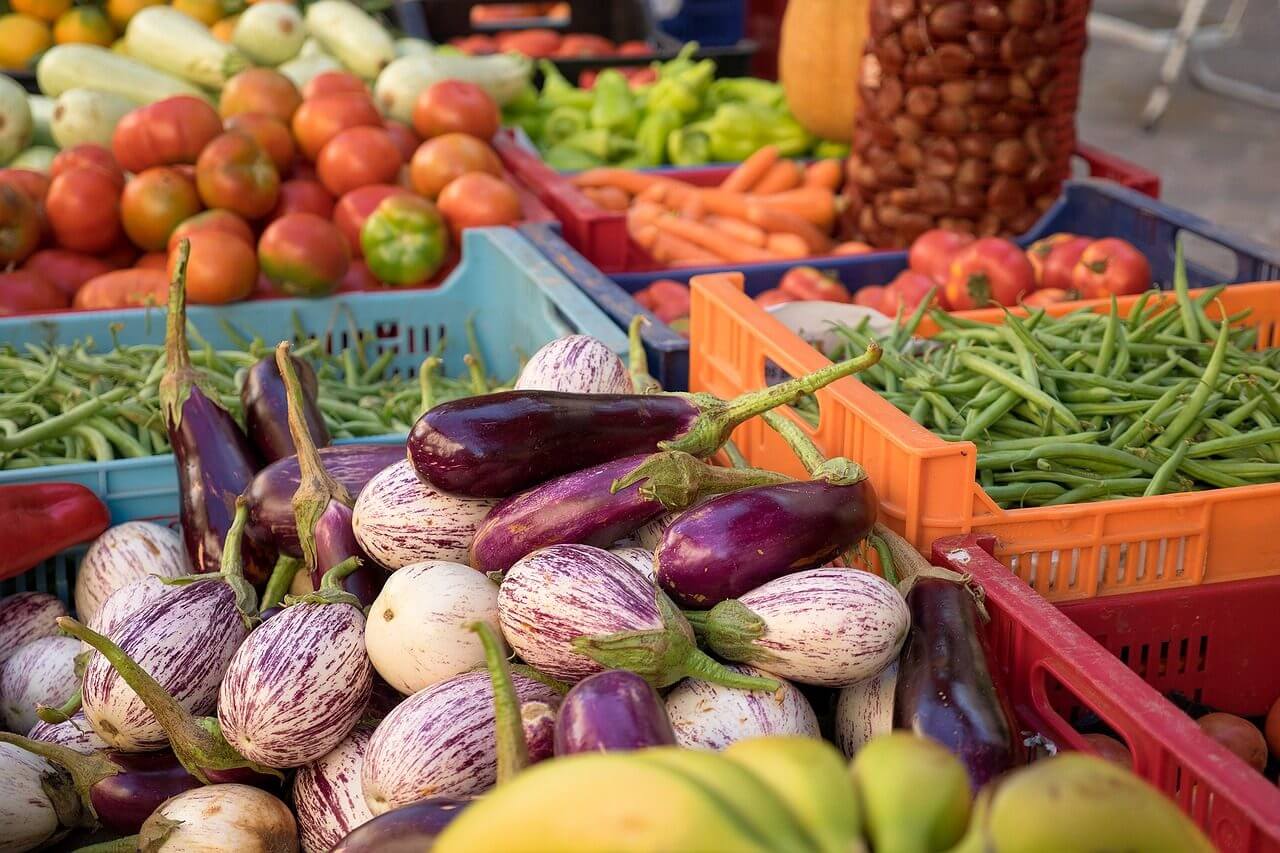

Leave A Comment